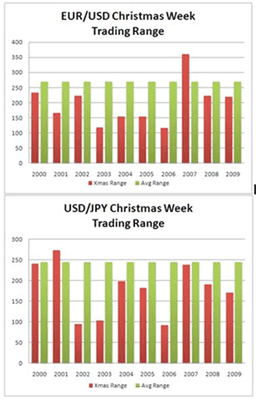There are two more weeks left until the end of the year and it already feels like the equity and currency markets have moved into holiday mode. There was no consistency in the dollar’s movement as equities and Treasuries stabilized. The greenback traded higher against the euro, British pound, and Canadian dollar, but weakened against the Japanese yen, Swiss franc, and the Australian and New Zealand dollars.
The lack of US economic data today (this week, really) has also contributed to the lack of volatility in the financial market. Milestones were reached, but none of them involved the US dollar—the euro fell to a record low against the Swiss franc, while the aussie climbed to a record high against the euro and decade high against the New Zealand dollar. Investors have not forgotten about Europe’s problems, which is why the euro and British pound have failed to rally. The US economic calendar remains devoid of any major economic reports tomorrow, which means that things should remain quiet.
In fact, with many traders having already closed their books and gone off to enjoy the holidays with their families, it should be relatively dead week in the financial markets (barring any major exogenous risks such as a war erupting in the Korean peninsula) due to "thin” trading conditions. Now many traders may wonder what “thin” trading conditions really means. By definition, it is an environment where trading activity is particularly light because of the lack of buyers and sellers in the market. This can lead to one of two completely opposite outcomes: A breakout or a range.
The reason why breakouts can occur in these conditions is because the lack of buyers or sellers creates a situation where it doesn't take much to trigger a sharp move in the currency. However, the lack of buyers or sellers can also lead to range trading if no one is motivated to take new positions. Based upon how the EUR/USD and USD/JPY have traded over the past decade during Christmas week, the odds of a breakout this week are low.
The above charts compare the trading range during Christmas week in the two currency pairs (red bars) to the average weekly trading range for the past ten years (green bars). For the EUR/USD, aside from 2007, the trading range this week tends to be below average.
For USD/JPY, the weekly range has also been below average every year except for 2001. In fact, the average trading range this week in the forex market tends to be approximately 25% less than the average trading range throughout the course of the year. Barring any crazy exogenous risk, it should be a very quiet week.
Thinly traded markets can be very unpredictable markets. Be careful putting on any large positions over the holidays as the charts can give false signals because volume just isn’t there to support the price action.
By Kathy Lien of KathyLien.com


















